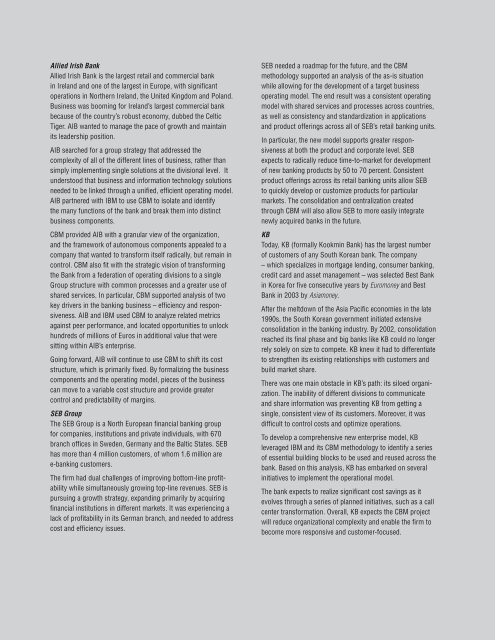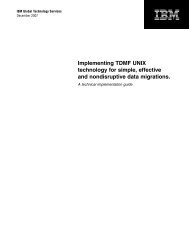Component business models - IBM
Component business models - IBM
Component business models - IBM
You also want an ePaper? Increase the reach of your titles
YUMPU automatically turns print PDFs into web optimized ePapers that Google loves.
Allied Irish Bank<br />
Allied Irish Bank is the largest retail and commercial bank<br />
in Ireland and one of the largest in Europe, with significant<br />
operations in Northern Ireland, the United Kingdom and Poland.<br />
Business was booming for Ireland’s largest commercial bank<br />
because of the country’s robust economy, dubbed the Celtic<br />
Tiger. AIB wanted to manage the pace of growth and maintain<br />
its leadership position.<br />
AIB searched for a group strategy that addressed the<br />
complexity of all of the different lines of <strong>business</strong>, rather than<br />
simply implementing single solutions at the divisional level. It<br />
understood that <strong>business</strong> and information technology solutions<br />
needed to be linked through a unified, efficient operating model.<br />
AIB partnered with <strong>IBM</strong> to use CBM to isolate and identify<br />
the many functions of the bank and break them into distinct<br />
<strong>business</strong> components.<br />
CBM provided AIB with a granular view of the organization,<br />
and the framework of autonomous components appealed to a<br />
company that wanted to transform itself radically, but remain in<br />
control. CBM also fit with the strategic vision of transforming<br />
the Bank from a federation of operating divisions to a single<br />
Group structure with common processes and a greater use of<br />
shared services. In particular, CBM supported analysis of two<br />
key drivers in the banking <strong>business</strong> – efficiency and responsiveness.<br />
AIB and <strong>IBM</strong> used CBM to analyze related metrics<br />
against peer performance, and located opportunities to unlock<br />
hundreds of millions of Euros in additional value that were<br />
sitting within AIB’s enterprise.<br />
Going forward, AIB will continue to use CBM to shift its cost<br />
structure, which is primarily fixed. By formalizing the <strong>business</strong><br />
components and the operating model, pieces of the <strong>business</strong><br />
can move to a variable cost structure and provide greater<br />
control and predictability of margins.<br />
SEB Group<br />
The SEB Group is a North European financial banking group<br />
for companies, institutions and private individuals, with 670<br />
branch offices in Sweden, Germany and the Baltic States. SEB<br />
has more than 4 million customers, of whom 1.6 million are<br />
e-banking customers.<br />
The firm had dual challenges of improving bottom-line profitability<br />
while simultaneously growing top-line revenues. SEB is<br />
pursuing a growth strategy, expanding primarily by acquiring<br />
financial institutions in different markets. It was experiencing a<br />
lack of profitability in its German branch, and needed to address<br />
cost and efficiency issues.<br />
<strong>Component</strong> <strong>business</strong> <strong>models</strong><br />
SEB needed a roadmap for the future, and the CBM<br />
methodology supported an analysis of the as-is situation<br />
while allowing for the development of a target <strong>business</strong><br />
operating model. The end result was a consistent operating<br />
model with shared services and processes across countries,<br />
as well as consistency and standardization in applications<br />
and product offerings across all of SEB’s retail banking units.<br />
In particular, the new model supports greater responsiveness<br />
at both the product and corporate level. SEB<br />
expects to radically reduce time-to-market for development<br />
of new banking products by 50 to 70 percent. Consistent<br />
product offerings across its retail banking units allow SEB<br />
to quickly develop or customize products for particular<br />
markets. The consolidation and centralization created<br />
through CBM will also allow SEB to more easily integrate<br />
newly acquired banks in the future.<br />
KB<br />
Today, KB (formally Kookmin Bank) has the largest number<br />
of customers of any South Korean bank. The company<br />
– which specializes in mortgage lending, consumer banking,<br />
credit card and asset management – was selected Best Bank<br />
in Korea for five consecutive years by Euromoney and Best<br />
Bank in 2003 by Asiamoney.<br />
After the meltdown of the Asia Pacific economies in the late<br />
1990s, the South Korean government initiated extensive<br />
consolidation in the banking industry. By 2002, consolidation<br />
reached its final phase and big banks like KB could no longer<br />
rely solely on size to compete. KB knew it had to differentiate<br />
to strengthen its existing relationships with customers and<br />
build market share.<br />
There was one main obstacle in KB’s path: its siloed organization.<br />
The inability of different divisions to communicate<br />
and share information was preventing KB from getting a<br />
single, consistent view of its customers. Moreover, it was<br />
difficult to control costs and optimize operations.<br />
To develop a comprehensive new enterprise model, KB<br />
leveraged <strong>IBM</strong> and its CBM methodology to identify a series<br />
of essential building blocks to be used and reused across the<br />
bank. Based on this analysis, KB has embarked on several<br />
initiatives to implement the operational model.<br />
The bank expects to realize significant cost savings as it<br />
evolves through a series of planned initiatives, such as a call<br />
center transformation. Overall, KB expects the CBM project<br />
will reduce organizational complexity and enable the firm to<br />
become more responsive and customer-focused.<br />
13

















